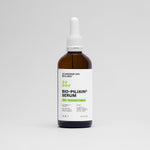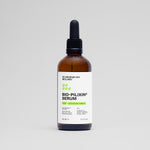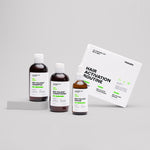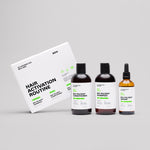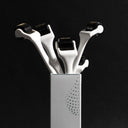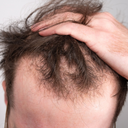The scalp is the unsung hero of hair health. While we often forget about it when it comes to hair care, that’s where everything starts, and it plays a crucial role in how your hair looks and feels. But how much do you know about taking care of it?
In this article, we’ll explore what makes a healthy scalp, the signs of any potential trouble and the causes behind it, and general tips on how you can keep your scalp happy.
What Makes Scalp Health as Important as Hair Health?
Like plants need good soil, your hair needs a healthy scalp. A damaged scalp can make your hair unhealthy. For example, research [1] with 20 studies showed that bad scalp health led to hair loss.
Scalp health depends on:
- pH, which is a measure of how acidic something is. The correct pH level for your scalp is about 5.5. Shampoos with a higher pH (over 5.5) can make your hair frizzy and weak. Unfortunately, most shampoos have a high pH. One study [2] found that 123 popular shampoos had a pH higher than 5.5.
- Controlling scalp oil (sebum). Your scalp makes oil to keep your hair smooth. But too much of it can lead to problems. For example, a study [3] showed that people with too much scalp oil experienced hair loss and itching problems.
- Scalp germs (bacteria and fungi). The scalp has tiny, helpful living things that stop dandruff. They also make amino acids and biotin, which help your hair grow [4].
How Does the Scalp Differ from the Rest of the Skin?
Your scalp needs unique products to keep it healthy. In other words, you cannot use skincare or hair products on your scalp. This is because your scalp differs from the skin on the rest of your body. When compared to the skin, the scalp has:
- More hair follicles [5]
- More oil (sebum) [6]
- Thicker skin layers. Your scalp has five skin layers, which is more than the rest of your body [7].
Recognising An Unhealthy Scalp: What Are the Signs?
Knowing what an unhealthy scalp looks like is vital to taking care of it. By spotting these signs, you can start caring for your scalp immediately.
Here's what to look out for:
- Dandruff
- Itchy scalp
- Scalp redness or inflammation
- Hair loss
- Too oily or dry scalp
- Pimples on your scalp
- Scaly patches
- Sensitivity. It needs attention if your scalp hurts when you touch it or brush your hair.

Uncovering the Root Causes of Scalp Issues
Your scalp may be unhealthy for several reasons. These include:
- A poor diet. In particular, if your diet lacks iron, zinc, vitamins (D, E, A), and proteins [8].
- Stress. Feeling stressed all the time can stop your hair from growing. Stress may keep your hair roots in a resting phase, preventing them from producing the chemicals necessary to trigger hair growth [9].
- A smoking habit. Smoking reduces blood flow to your scalp and can cause hair loss and skin problems [10].
- Toxin exposure. Excessive sun exposure and even some hair treatments can hurt your scalp [11].
- Product buildup. This can clog your hair roots and lead to dandruff, infections, and even hair loss [12].
- Hormonal imbalances. For example, excessive quantities of dihydrotestosterone (DHT) can make your scalp oily [13]. Likewise, changes during menopause can make your scalp dry and itchy [14].
How Can You Improve Your Scalp Health for Better Hair?
Taking care of your scalp can make your hair healthier. You can achieve this by:
- Regularly cleansing. Frequent scalp cleaning is vital. Otherwise, dirt and oil can build up, making it easy for fungus to grow. A study[15] compared people who washed their scalp 5-6 times a week to those who only washed it once a week. Unsurprisingly, the frequent washers experienced less inflammation, dandruff, and itching.
- Using the right products. Picking the right products for your scalp can revolutionise your hair. A study [16] where participants used these products for 24 weeks illustrated this. The participants reported lesser hair fall and more vibrant hair.
- Keeping germs balanced. Dandruff develops when the germs on your scalp get out of balance, which can not only impact your scalp but it can also make hair weaker. Fortunately, re-creating the germ balance is possible. For example, one study [17] found that coconut oil strengthens the scalp's bacteria. Likewise, shampoos with heat-killed probiotics can increase good scalp bacteria [18].
Choosing the Right Scalp Care Products
Picking the right products for your scalp is like choosing the best food for your body. First, establish the type of your scalp is and what problems it faces (dryness, excessive oil products, irritation, etc.) Then, look for ingredients that target your specific needs.
For example, if you have a:
- Dry scalp, products with hydrating ingredients [19] like hyaluronic acid and aloe vera can be a good choice. These keep your scalp from getting dry and flaky.
- Oily scalp, ingredients like salicylic acid and green tea extract can be useful. These help remove dead skin, extra oil, and product buildup.
- Sensitive scalp, products with gentle ingredients like chamomile can hepl soothe the skin. At the same time, avoid chemicals like sulfates and parabens that might irritate your skin.
Remember, these are general recommendations. For more personalised suggestions, it’s always best to consult your medical provider.

Tips for maintaining a healthy scalp
Taking care of your scalp is about more than using the right products. It's also about good habits and practices. Here are some general tips for a healthy scalp and hair:
- Avoid tight hairstyles. Styles like tight buns, braids, and ponytails can pull on your hair too much. This could lead to hair loss called traction alopecia [21].
- Wash your hair at an appropriate frequency. Washing dry scalp with a stripping shampoo too often may lead to even more dryness and irritation, while not washing an oily scalp infrequently can cause oil and dirt to buildup.
- Brush your hair gently when styling to avoid hurting your scalp.
- Space out chemical treatments. If you dye your hair or use chemicals to straighten it, wait at least 8-10 weeks between treatments. This prevents product buildup. It also allows your hair and scalp to recover between treatments.
- Eat well and stay hydrated. A diet rich in vitamins (B, D, A, E), fatty acids, iron, and zinc suits your hair. Also, drinking enough water keeps your scalp from getting dry and flaky.
- Manage stress. Too much stress can lead to hair loss. Try relaxing with meditation, exercise, and getting enough sleep.
- Choose the right products. Use hair products and oils that don't clog your pores and fit your needs.
- Get regular scalp massages. Massaging your scalp can reduce stress and improve blood flow to it.
Takeaway
Your scalp is like the soil for your hair. Looking after it should be a part of a healthy hair care routine. Begin by learning all about your scalp and try to spot signs of any potential trouble. Choose products that are tailored to your specific needs and don’t forget to consult a dermatologist when in doubt.
Remember, there is more to scalp health than just the right products. Be mindful of your diet, stress levels, and styling habits. Every small step is a giant leap towards healthier hair.
References:
-
Tosti A, Schwartz JR. Role of scalp health in achieving optimal hair growth and retention. Int J Cosmet Sci. 2021;43 Suppl 1. doi:10.1111/ics.12708
-
Ma L, Guichard A, Cheng Y, Li J, Qin O, Wang X, et al. Sensitive scalp is associated with excessive sebum and perturbed microbiome. J Cosmet Dermatol. 2019;18(3). doi:10.1111/jocd.12736
-
Grimshaw SG, Smith AM, Arnold DS, Xu E, Hoptroff M, Murphy B. The diversity and abundance of fungi and bacteria on the healthy and dandruff affected human scalp. PLoS One. 2019;14(12). doi:10.1371/journal.pone.0225796
-
Visessiri Y, Pakornphadungsit K, Leerunyakul K, Rutnin S, Srisont S, Suchonwanit P. The study of hair follicle counts from scalp histopathology in the Thai population. Int J Dermatol. 2020;59(8). doi:10.1111/ijd.14989
-
Shamloul G, Khachemoune A. An updated review of the sebaceous gland and its role in health and diseases Part 1: Embryology, evolution, structure, and function of sebaceous glands. Dermatol Ther. 2021;34(1). doi:10.1111/dth.14695
-
How stress causes hair loss. National Institutes of Health (NIH). Published April 12, 2021. https://www.nih.gov/news-events/nih-research-matters/how-stress-causes-hair-loss. Accessed November 27, 2023
-
Chiu CH, Huang SH, Wang HM. A Review: Hair Health, Concerns of Shampoo Ingredients and Scalp Nourishing Treatments. Curr Pharm Biotechnol. 2015;16(12). doi:10.2174/1389201016666150817094447
-
Grymowicz M, Rudnicka E, Podfigurna A, Napierala P, Smolarczyk R, Smolarczyk K, et al. Hormonal Effects on Hair Follicles. Int J Mol Sci. 2020;21(15). doi:10.3390/ijms21155342
-
Zouboulis CC, Blume-Peytavi U, Kosmadaki M, Roó E, Vexiau-Robert D, Kerob D, et al. Skin, hair and beyond: the impact of menopause. Climacteric. 2022;25(5). doi:10.1080/13697137.2022.2050206
-
Davis MG, Piliang MP, Bergfeld WF, Caterino TL, Fisher BK, Sacha JP, et al. Scalp application of antioxidants improves scalp condition and reduces hair shedding in a 24-week randomized, double-blind, placebo-controlled clinical trial. Int J Cosmet Sci. 2021;43 Suppl 1. doi:10.1111/ics.12734
-
Saxena R, Mittal P, Clavaud C, Dhakan DB, Roy N, Breton L, et al. Longitudinal study of the scalp microbiome suggests coconut oil to enrich healthy scalp commensals. Sci Rep. 2021;11. doi:10.1038/s41598-021-86454-1
-
Tsai WH, Fang YT, Huang TY, Chiang YJ, Lin CG, Chang WW. Heat-killed Lacticaseibacillus paracasei GMNL-653 ameliorates human scalp health by regulating scalp microbiome. BMC Microbiol. 2023;23(1). doi:10.1186/s12866-023-02870-5
-
How to treat dandruff. https://www.aad.org/public/everyday-care/hair-scalp-care/scalp/treat-dandruff. Accessed November 27, 2023
-
Pulickal JK, Kaliyadan F. Traction Alopecia. Published online January 2023. [https://pubmed.ncbi.nlm.nih.gov/29262008/.](https://pubmed.ncbi.nlm.nih.gov/29262008/) Accessed November 27, 2023

